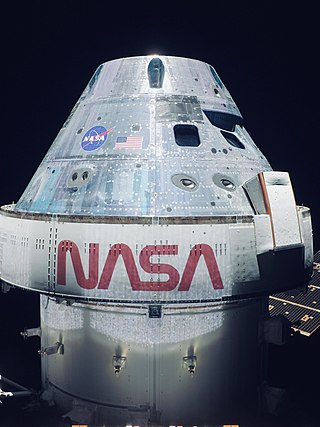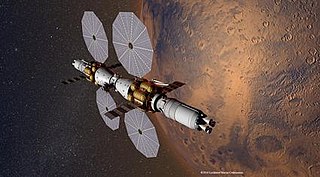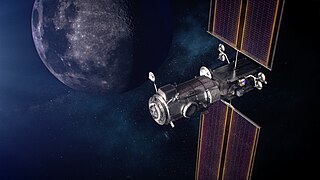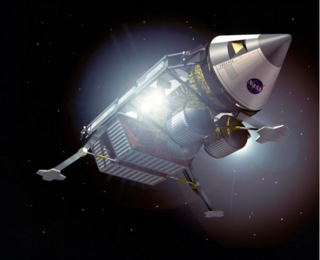
The Constellation program was a crewed spaceflight program developed by NASA, the space agency of the United States, from 2005 to 2009. The major goals of the program were "completion of the International Space Station" and a "return to the Moon no later than 2020" with a crewed flight to the planet Mars as the ultimate goal. The program's logo reflected the three stages of the program: the Earth (ISS), the Moon, and finally Mars—while the Mars goal also found expression in the name given to the program's booster rockets: Ares. The technological aims of the program included the regaining of significant astronaut experience beyond low Earth orbit and the development of technologies necessary to enable sustained human presence on other planetary bodies.

The Crew Exploration Vehicle (CEV) was a component of the U.S. NASA Vision for Space Exploration plan. A competition was held to design a spacecraft that could carry humans to the destinations envisioned by the plan. The winning design was the Orion spacecraft.

Inflatable habitats or expandable habitats are pressurized tent-like structures capable of supporting life in outer space whose internal volume increases after launch. They have frequently been proposed for use in space applications to provide a greater volume of living space for a given mass.

The Space Exploration Vehicle (SEV) is a modular vehicle concept developed by NASA from 2008 to 2015. It would have consisted of a pressurized cabin that ccould be mated either with a wheeled chassis to form a rover for planetary surface exploration or to a flying platform for open space missions such as servicing satellites and missions to near-Earth asteroids. The concept evolved from the Lunar Electric Rover (LER) concept, which in turn was a development of the Small Pressurized Rover (SPR) concept.

Node 4, also known as the Docking Hub System (DHS), was a proposed module of the International Space Station (ISS). In 2011 NASA was considering a 40-month design and development effort for Node 4 that would result in its launch in late 2013.

Nautilus-X is a rotating wheel space station concept developed by engineers Mark Holderman and Edward Henderson of the Technology Applications Assessment Team of NASA.

Orion is a partially reusable crewed spacecraft used in NASA's Artemis program. The spacecraft consists of a Crew Module (CM) space capsule designed by Lockheed Martin and the European Service Module (ESM) manufactured by Airbus Defence and Space. Capable of supporting a crew of four beyond low Earth orbit, Orion can last up to 21 days undocked and up to six months docked. It is equipped with solar panels, an automated docking system, and glass cockpit interfaces modeled after those used in the Boeing 787 Dreamliner. A single AJ10 engine provides the spacecraft's primary propulsion, while eight R-4D-11 engines, and six pods of custom reaction control system engines developed by Airbus, provide the spacecraft's secondary propulsion. Orion is intended to launch atop a Space Launch System (SLS) rocket, with a tower launch escape system.

The Exploration Gateway Platform was a design concept proposed by Boeing in December 2011 to drastically reduce the cost of Moon, near Earth asteroids (NEAs), or Mars missions by using components already designed to construct a refueling depot and servicing station located at one of the Earth–Moon Lagrange points, L1 or L2. The system claims its cost savings based on an ability to be reused for multiple missions such as a launch platform for deep space exploration, robotic relay station for moon rovers, telescope servicing and a deep space practice platform located outside the Earth's protective radiation belts.

Skylab II was a space station concept proposed in 2013 by the Advanced Concepts Office of NASA Marshall Space Flight Center, to be located at the Earth-Moon L2 Lagrangian point. Proposed by NASA contractor Brand Griffin, Skylab II would have been constructed as a "wet workshop" using a spent upper-stage hydrogen fuel tank from the Space Launch System (SLS), much as the Skylab was originally planned to be built "wet" from the spent bipropellant tanks of the Saturn S-IVB upper stage. If constructed, Skylab II would have been the first crewed outpost located beyond the orbit of the Moon.

Artemis 3 is planned as the first crewed Moon landing mission of the Artemis program and the first crewed flight of the Starship HLS lander. Artemis 3 is planned to be the second crewed Artemis mission and the first crewed lunar landing since Apollo 17 in December 1972. As of 2023, the mission is scheduled for December 2025.

Mars Base Camp (MBC) is a crewed Mars laboratory orbiter concept under study that was commissioned by NASA from Lockheed Martin in US. It would use both future and proven concepts as well as the Orion MPCV, also built by Lockheed Martin.

The Deep Space Transport (DST), also called Mars Transit Vehicle, is a crewed interplanetary spacecraft concept by NASA to support science exploration missions to Mars of up to 1,000 days. It would be composed of two elements: an Orion capsule and a propelled habitation module. As of late 2019, the DST is still a concept to be studied, and NASA has not officially proposed the project in an annual U.S. federal government budget cycle. The DST vehicle would depart and return from the Lunar Gateway to be serviced and reused for a new Mars mission.

The Lunar Gateway, or simply Gateway, is the first planned extraterrestrial space station. It will be placed in lunar orbit and is intended to serve as a solar-powered communication hub, science laboratory, and short-term habitation module for government-agency astronauts, as well as a holding area for rovers and other robots. It is a multinational collaborative project involving four of the International Space Station partner agencies: NASA, European Space Agency (ESA), Japan Aerospace Exploration Agency (JAXA), and Canadian Space Agency (CSA). It is planned to be both the first space station beyond low Earth orbit and the first space station to orbit the Moon.

The Artemis program is a robotic and crewed Moon exploration program led by the United States' National Aeronautics and Space Administration (NASA) along with six major partner agencies— the European Space Agency (ESA), the German Aerospace Center (DLR), the Japan Aerospace Exploration Agency (JAXA), the Canadian Space Agency (CSA), the Israel Space Agency (ISA), and the Italian Space Agency (ASI). The Artemis program is intended to reestablish a human presence on the Moon for the first time since the Apollo 17 mission in 1972. The main parts of the program are the Space Launch System (SLS), the Orion spacecraft, the Lunar Gateway space station, and the commercial Human Landing Systems. The program's long-term goal is to establish a permanent base on the Moon to facilitate the feasibility of crewed missions to Mars.

Artemis 4 is the fourth planned mission of NASA's Artemis program. The mission will launch four astronauts on a Space Launch System rocket and an Orion to the Lunar Gateway and the second lunar landing of the Artemis program.

Artemis 5 is the fifth planned mission of NASA's Artemis program and the first crewed flight of the Blue Moon lander. The mission will launch four astronauts on a Space Launch System rocket and an Orion to the Lunar Gateway and will be the third lunar landing of the Artemis program. In addition, Artemis V will also deliver two new elements to the Gateway Space Station.

The International Lunar Resources Exploration Concept (ILREC) was a proposed mission architecture under President George H. W. Bush's Space Exploration Initiative (SEI) by Kent Joosten, an engineer at Johnson Space Center. The plan would have used the help of international partners, mainly the Soviet Union, to assemble a lunar base and sustainable lunar transportation service.

The Power and Propulsion Element (PPE), previously known as the Asteroid Redirect Vehicle propulsion system, is a planned solar electric ion propulsion module being developed by Maxar Technologies for NASA. It is one of the major components of the Gateway. The PPE will allow access to the entire lunar surface and a wide range of lunar orbits and double as a space tug for visiting craft.

The International Habitation Module, International Habitat or I-HAB is designed as the main habitat module of the Lunar Gateway station, to be built by the European Space Agency (ESA) in collaboration with the Japan Aerospace Exploration Agency, or JAXA. The I-HAB will have a maximum launch mass of 10,000 kg (22,000 lb) and provide a habitable volume of 10 m3 (350 cu ft).























